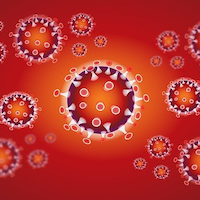Article
COVID-19-Induced Thyroid Infection Identified in Italian Patient
Author(s):
New data found an 18-year-old female patient developed subacute thyroiditis following a COVID-19 infection.

Data from a new case study from investigators at a hospital in Italy suggest coronavirus disease 2019 (COVID-19) could cause subacute thyroiditis.
Based on the chronological association observed in an 18-year-old patient, clinicians from the hospital suggest SARS-CoV-2 could be considered accountable for the onset of subacute thyroiditis in the patient.
“We reported the first case of subacute thyroiditis after SARS-CoV-2 infection,” said lead investigator Francesco Latrofa, MD, of the University Hospital of Pisa in Pisa, Italy, in a statement. “Physicians should be alerted about the possibility of this additional clinical manifestation related to COVID-19.”
Published in The Journal of Clinical Endocrinology & Metabolism, the 12-page study outlines what investigators suggest would be the first instance of subacute thyroiditis caused by COVID-19. The 18-year-old female who underwent an oropharyngeal swab for SARS-CoV-2 on February 28, 2020—just 2 days after her father, who she lived with, was hospitalized with COVID-19.
Over the following days, the patient developed rhinorrhea and cough, which investigators classified as mild. These were left untreated and the patient completely recovered in 4 days. The patient subsequently underwent 2 additional swabs for SARS-CoV-2 on March 13 and March 14—both of these swabs came back negative.
Following the negative swabs, the patient developed a sudden 99.5 °F fever, fatigue, palpitations, and anterior neck pain radiating to the jaw. Due to this pain, the patient was referred to the University Hospital of Pisa on March 19.
A physical examination at the hospital indicated a heart rate of 90 beats per minute and, on palpation, the thyroid gland was enlarged, slightly tender, and markedly painful. Results of laboratory exams indicated high levels of free thyroxine (FT4) and free triiodothyronine (FT3), undetectable TSH, and elevated inflammatory markers and white blood cell count. Neck ultrasound performed at the hospital indicated bilateral and diffuse hypoechoic areas.
Of note, an examination from February 20, 2020 indicated normal thyroid function and imaging. Upon treatment with 25 mg/d prednisone, the patient’s fever and neck pain subsided within 2 days and the remaining symptoms dissipated within a week. A follow-up visit conducted on April 27 returned normal thyroid function tests and inflammatory markers.
“To our knowledge, this is the first case of SAT related to SARS-CoV-2. Because of the chronological association, SARS-CoV-2 may be considered accountable for the onset of subacute thyroiditis,” investigators concluded.
This study, “Subacute Thyroiditis After SARS-CoV-2 Infection,” was published in The Journal of Clinical Endocrinology & Metabolism.




